Being a parent means thinking about one hundred things including the following: How many diapers should I stockpile?
How many pacifiers do I need? Do I need them at all?
While diapers are non-negotiable because they’re an essential item for every baby and their parent, pacifiers are still up for debate.
Some parents praise baby’s pacifiers and see them as genuine life-savers and others are against them.
I can’t tell you whether or not you should give your baby a soother because every parent should decide for themselves and their baby.
But, I can tell you everything you need to know about them so that you can make an informed decision.
Another thing that is also debatable regarding soothers is the right amount to stockpile.
Do you need 10, 5, or only 1 soother?
As with everything, this depends on your lifestyle, your baby’s needs, and how likely you are to lose things.
To help you decide how many pacifiers you should put on the list for your baby registry, or which ones to choose, here’s all you need to know about baby’s pacifiers!
How Many Pacifiers Do I Need?
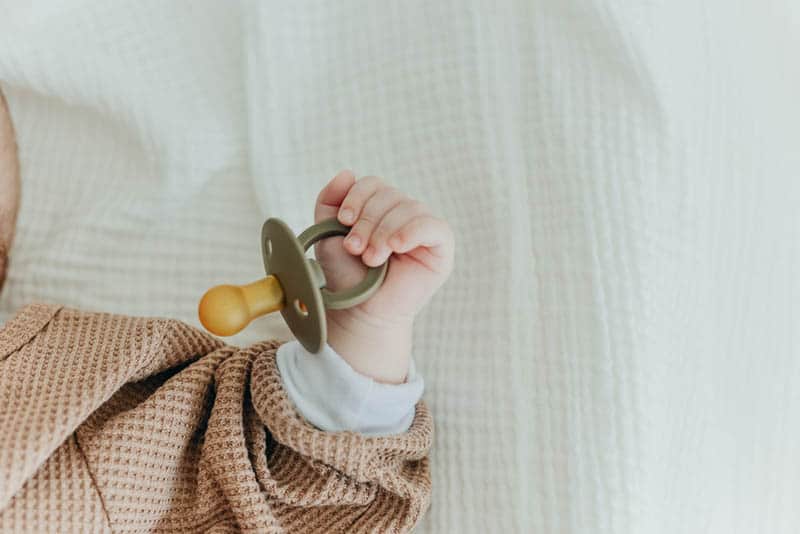
A million-dollar question for every parent out there: How many pacifiers do I need?
Maybe we should rephrase this question to: How many pacifiers does a baby need?
Well, the answer to this question varies from parent to parent and it depends on the age of your little one as well.
Basically, every parent needs about three soothers for their little one.
Keep in mind that you should always carry extras (particularly if you’re on the road often).
It’s recommended to have a soother in the diaper bag, attached to the stroller and car seat, in the living room / the nursery, etc. so that you have a soother on hand at every occasion.
A replacement soother is a must-have in case your baby drops it (chances of this happening are really high), or loses it.
Also, some children prefer certain soothers over others so when you offer them the one they don’t like, they will not want to use it.
Because of that, it’s wise to stockpile their favorite soother. Another wise tip is not to overdo it because as babies grow, soothers need to be changed accordingly.
Do You Really Need Pacifiers?
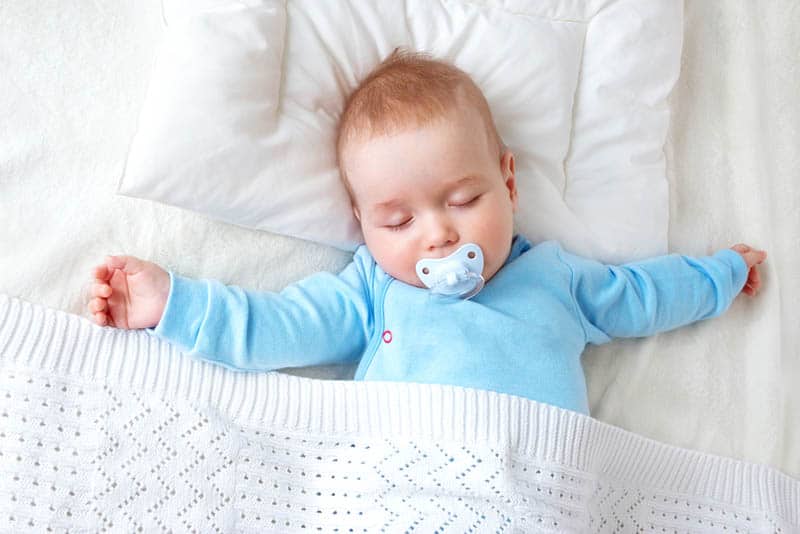
Before stockpiling pacifiers, there’s another important question every parent faces at some point and that is: Do I actually need pacifiers?
If yes, why?
If you’re a first-time parent, this will be even more confusing for you, but don’t worry, I’ve got the answers for you.
American Academy of Pediatricians (AAP) claims the following: “Pacifiers do not cause any medical or psychological problems. If your baby wants to suck beyond what nursing or bottle-feeding provides, a pacifier will satisfy that need. However, a pacifier should not be used to replace or delay meals.”
If you’re one of those parents worrying about risks associated with pacifiers, the above is the answer to your questions and concerns.
Now that we’ve got that straight, let’s shift to the question: Why do you need a pacifier aka paci, binky, soother?
The answer to this question is pretty much self-explanatory.
Babies need different types of soothers to soothe themselves.
For example, some babies suck their lower lip while other babies chew their tongue as a form of self-soothing.
With that being said, let’s have a closer look at the benefits that soothers offer to little ones.
Benefits of pacifiers
• Soothers help with breastfeeding.
• Pacifier use reduces the risk of SIDS / the risk of Sudden Infant Death Syndrome.
• It helps to soothe a crying and fussy baby.
• It helps babies fall asleep.
• The use of pacifiers increases gastrin secretion which helps improve the baby’s digestion.
• Helps infants develop a sucking reflex.
• Helps infants in NICU (Neonatal Intensive Care Unit) environments who are in need of pain relief, soothing, and stress release.
Now that you’re familiar with all the benefits that soothers provide, it’s up to you to decide whether your baby will use them or not.
If you decide to use it, don’t forget to put it on the list of things to pack for daycare as well.
When Is The Right Time To Introduce Your Baby To A Pacifier?

The answer to this question depends on whether you’re planning to breastfeed your baby or not.
If you decide to bottle-feed your baby
If, for some reason, bottle-feeding over breastfeeding is the only or better option for you and your baby, you can introduce your baby to a soother immediately.
Before giving your baby a soother, it’s advisable that you take some time to learn his/her cues when it comes to feeding, gas, sleeping, or pain so that you always know exactly what your baby needs and wants.
Also, it’s recommended that you wait a few days (approximately 10) until you see that your baby has gained some weight before introducing your baby to a soother.
If you decide to breastfeed your baby
If you plan on breastfeeding your baby, it’s recommended that you wait a few weeks (around 6) before introducing your baby to a soother.
You should allow your baby to establish a breastfeeding routine before they start using a pacifier.
If you introduce your baby to one before they have established their feeding routine, they might become confused.
A soother is different from sucking on a breast so if your child starts using a soother before learning to suck on a breast, they might experience what’s known as nipple confusion.
The worst case scenario is your baby sucking on your breast in the wrong way and because of that being hungry most of the time.
So, if you decide to breastfeed your baby, give your baby some time to get used to breastfeeding first.
If you notice that your baby has established their breastfeeding routine before 6 weeks, then you can introduce them to a soother earlier.
If Your Baby Does These Things, Then It’s Time To Introduce Them To A Pacifier

If you’re a parent, you probably know that babies give clues for everything but sometimes it’s hard to decipher what it is that they really want.
If your baby is doing the following things, then it might be the time for you to introduce them to a soother:
• Your baby continues suckling on their bottle even when it’s completely empty.
• They suck on their thumbs/fingers.
• Your baby suckles on your breast but doesn’t draw any milk.
• They suck toys, blankets, or other things.
These are all hints that your baby desires a soother. Still, keep in mind that not all babies give clues that they would like a soother.
The best bet is to try offering them one to see if they accept it or not.
If they do, then you know that’s exactly what they want.
7 Things To Pay Attention To Before Buying A Pacifier
Choosing the right pacifier for your little one is as important as choosing the right mattress, diapers, or similar.
Before buying it, there are some things you need to pay attention to so that you find the best one for your child:
1. Look for pacifiers that are appropriate for your baby’s age
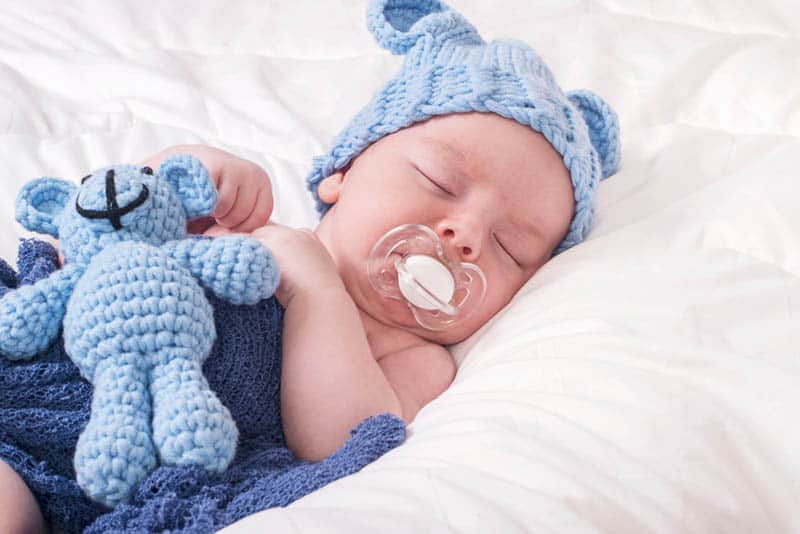
Here’s the thing, if you choose a soother that’s too small, there’s a danger of it becoming a choking hazard.
If you choose one that is too big, this might affect your baby’s teeth development and speech.
There are soothers of different sizes for a reason.
You shouldn’t choose a soother that is too small or too big for your baby’s mouth.
Instead, make sure that it’s for the right age and that it fits perfectly.
2. Choose a pacifier with an orthodontic design
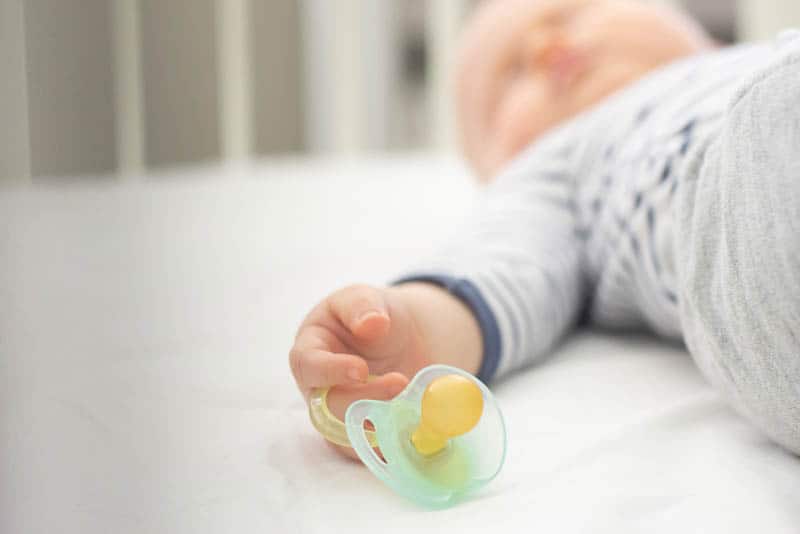
Even though your baby doesn’t have teeth yet, this doesn’t mean you should neglect their future development.
Choosing a soother with an orthodontic design is the best bet because this will help support your baby’s teeth and gums.
3. Always choose one-piece pacifiers
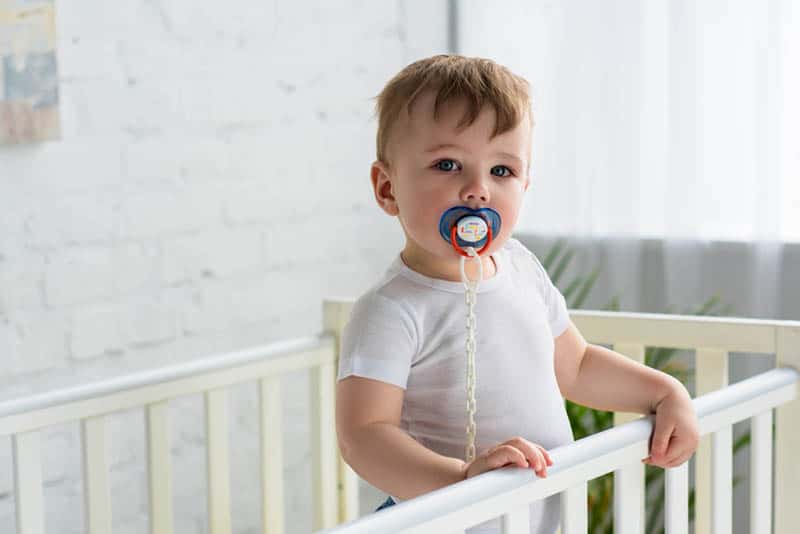
We all know that babies are susceptible to choking hazards (especially if they are left unattended).
Because of this, you should ALWAYS choose soothers that are made of one piece.
That way you won’t need to worry about it coming apart and causing suffocation.
4. Avoid pacifiers that are scented
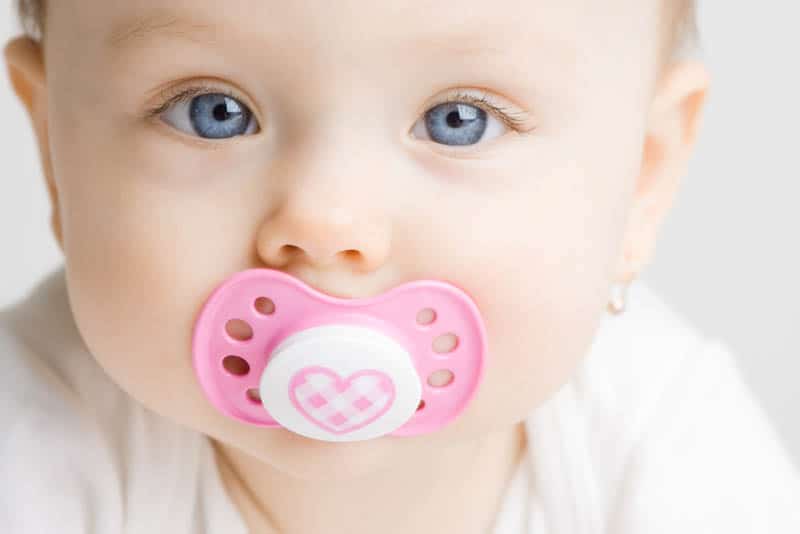
In today’s modern times, we have so many scented things and soothers are no exception.
Still, parents should avoid using scented soothers because they might contain chemicals that help those soothers stay scented.
If you still choose to use soothers that are scented, make sure to check that there’s nothing harmful to the baby in the soother.
If you’re wondering why someone would invent scented soothers, it’s because these scents, apparently, help soothe babies.
Still, there’s no real evidence for scented soothers being more effective than the unscented ones.
It’s important to mention that some babies might not like the scent of a soother and because of that refuse to use one.
If you ask me, I would suggest using the unscented ones so that you’re on the safe side and you don’t risk your baby developing an aversion to certain scents.
5. Pay attention to what material soothers are made of
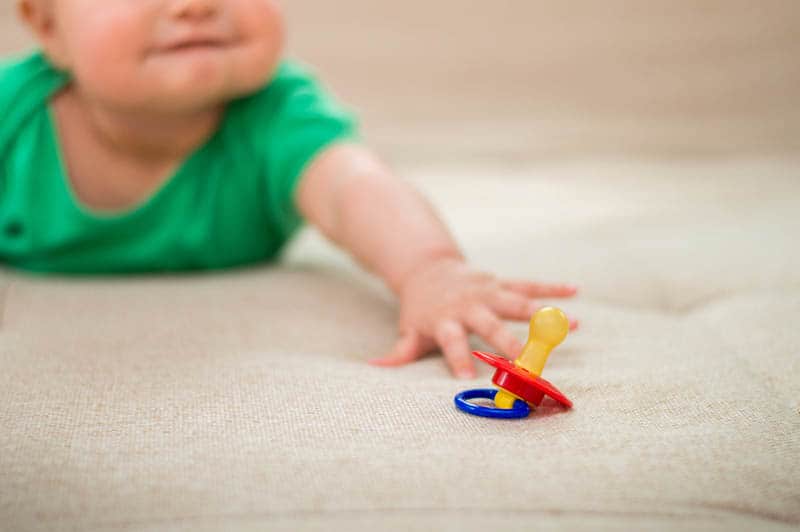
As always, silicone pacifiers and natural rubber pacifiers should be preferred among parents.
If you choose silicone ones, know that their shape will not expand through time.
But if you choose soothers made of natural rubber, they might expand with use which means you need to replace them more frequently.
Also, keep in mind that some babies may have latex allergies even though this is really rare.
But, if you notice that your baby is having a reaction to a soother made of latex, then make sure to avoid using them in the future.
6. Choose a soother with a large shield and ventilation holes
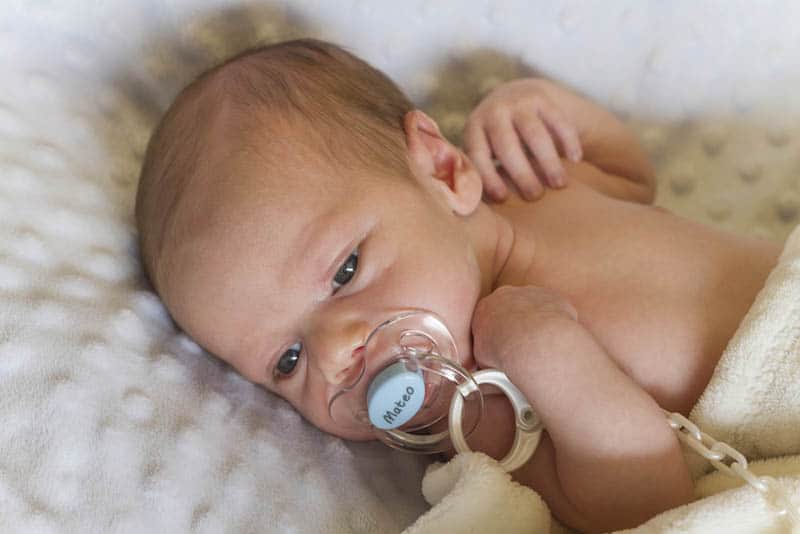
You should choose a soother with a large shield so that you avoid choking hazards.
Another thing you need to pay attention to is making sure that the shield contains ventilation holes for airflow.
7. Make sure the soothers have a symmetrical nipple shape

The whole point of giving your baby a soother is to give them something that’s an alternative to nipples when breastfeeding.
If a design doesn’t match the nipple shape, your child might be reluctant to use it.
Also, the nipple shape helps promote healthy oral development.
Apart from worrying about how many pacifiers you need or their benefits, another important thing is to actually FIND the right one.
To help you save time, here are some of the best pacifiers for your baby.
4 Best Pacifiers For Your Little One
1. Philips Avent Soothie Pacifier
- From the pacifier brand distributed in hospitals nationwide, used by doctors & nurses to soothe newborns
- One piece construction specially sized and shaped for babies 0-3 months old; adheres to the American Academy of Pediatrics guidelines
- Orthodontic design respects the natural development of babys teeth and gums
Prices pulled from the Amazon Product Advertising API on:
Product prices and availability are accurate as of the date/time indicated and are subject to change. Any price and availability information displayed on [relevant Amazon Site(s), as applicable] at the time of purchase will apply to the purchase of this product.
The first thing that makes these soothers stand out from the rest is their cute design.
They come in the shape of a bear thus giving it an adorable and cute look.
Another, more important thing that makes these soothers great is their orthodontic design which is a must because it supports your baby’s teeth and gums.
It is one-piece (no need to worry about choking hazards, parents) and it is free of BPA and latex.
This soother is suitable for babies 0-3 months old.
2. Chicco PhysioForma 100% Soft Silicone One-Piece Pacifier
- Actively supports baby’s breathing
- Clinically developed, tested, and approved in partnership with an advisory panel of leading neonatologists, pediatricians, and orthodontists
- Lateral curve of the nipple evenly distributes the tongue’s pressure against the palate
Prices pulled from the Amazon Product Advertising API on:
Product prices and availability are accurate as of the date/time indicated and are subject to change. Any price and availability information displayed on [relevant Amazon Site(s), as applicable] at the time of purchase will apply to the purchase of this product.
Just as the previous one, this soother is free of BPA and latex and it also has ventilation holes.
Now, what makes this one different from the rest is a lateral curve that helps distribute the pressure of the tongue evenly.
This ensures that a baby has proper tongue placement.
This soother is suitable for babies 0-6 months.
3. The First Years Gumdrop Orthodontic Pacifier
- GUMDROP PACIFIERS: These latex-free silicone pacifiers are trusted by hospitals worldwide
- UNIQUE CONTOUR SHAPE: Lightweight pacifiers are designed to fit babys face without hiding nose
- NEWBORN PACIFIERS: Available in bright colors and work with most pacifier attachers
Prices pulled from the Amazon Product Advertising API on:
Product prices and availability are accurate as of the date/time indicated and are subject to change. Any price and availability information displayed on [relevant Amazon Site(s), as applicable] at the time of purchase will apply to the purchase of this product.
This is one of the best pacifiers for babies who breastfeed.
The best thing about it is its orthodontic design which should be the first thing to look for in a soother.
Its nipple shape is responsible for the baby’s healthy oral development which is another plus.
Also, this soother works with the majority of soother attachers as well (there will be no more frustration about finding the right attacher).
4. NUK Space Orthodontic Pacifier
- Extra-large openings in the shield provide maximum airflow and allow babys sensitive skin to breathe
- Orthodontic nipple shape is asymmetrical with a scooped bottom: Flatter to allow for more room for natural sucking motion, slimmer to reduce pressure on jaw and teeth, and narrower to help prevent teeth misalignment
- Heart-shaped shield fits perfectly under babys nose for easy breathing
Prices pulled from the Amazon Product Advertising API on:
Product prices and availability are accurate as of the date/time indicated and are subject to change. Any price and availability information displayed on [relevant Amazon Site(s), as applicable] at the time of purchase will apply to the purchase of this product.
Anyone who sees these soothers is doomed to fall in love with them eternally.
Its design is super cute and, best of all, this type of design allows more airflow which in turn prevents any irritation on the baby’s sensitive skin.
Safety Tips To Follow
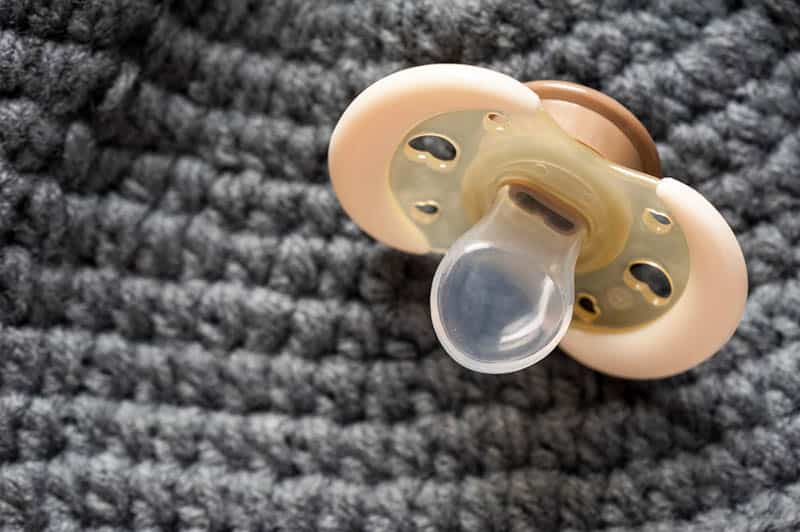
Check soothers before giving them to your baby
This is the most important thing that every parent should do before offering their baby a soother.
You need to inspect it to make sure that the soother is in perfect condition.
Just like everything else, soothers can crack which increases the risk of experiencing choking hazards.
Before giving your child a soother, check whether it’s dirty and if it needs to be sterilized.
That way you’ll help stop any harmful germs from entering your baby’s digestive system.
Sterilize soothers before giving them to your baby
Yes. Every new pacifier should be sterilized in boiling water before usage.
You can use a stove or a microwave (whichever is more convenient for you).
This will kill any germs that soothers may contain.
If your baby loses a soother or drops it, you need to sterilize it again. Repeat the sterilizing process as needed.
Don’t let your baby share soothers with others
We all know that saying, “Sharing is caring,” but unfortunately this cannot be applied to soothers.
Also, we all know that babies like to share things with other babies or adults.
Your job is to prevent them from sharing their soother with others so that you avoid the accumulation of germs on their soother or other potential illnesses.
As always, it’s best to be on the safe side.
When To Start Weaning Your Child Off Their Pacifier?

In order to avoid any potential dental issues, it’s advisable that you start weaning your baby off their soothers when they reach the age of six months to approximately one year.
If you’re not sure how to wean your child off the soother, this is how you’ll do it.
You need to decrease the number of times you give your child a soother in one day.
Through time, your child should only be able to use it during stressful situations or during nap time.
Also, both the American Academy of Pediatrics and the American Academy of Family Physicians suggest that parents limit or stop pacifier usage around 6 months to avoid ear infections.
FAQ
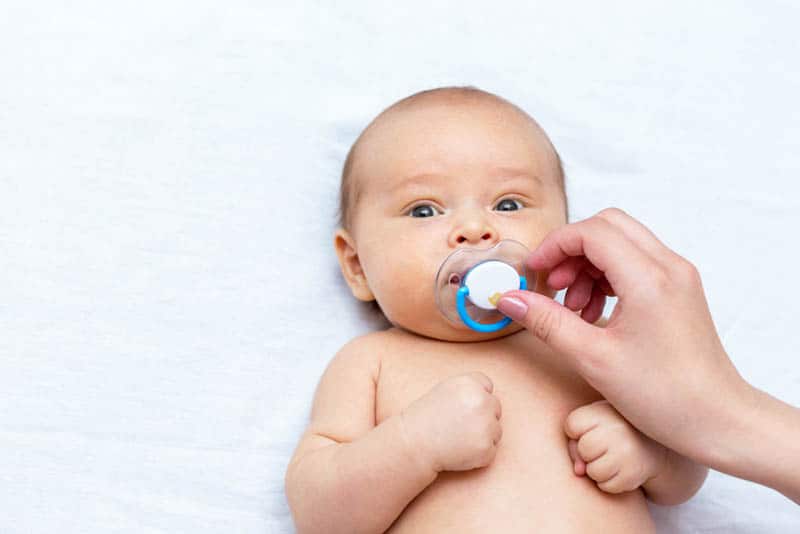
How many pacifier holders do I need?
In the world of soothers, soother holders and clips are the best inventions since sliced bread.
They don’t only keep them clean but also help your baby learn to get their soother when they need it.
So, how many soother holders do you need? You can get a few (2-3) and remember to keep one in your diaper bag in case you lose the rest of them.
Can breastfed babies use soothers?
You have probably stumbled upon some articles where they mention nipple confusion.
Well, there’s nothing to worry about because breastfed babies can use soothers without any potential problems or complications.
Still, there’s one thing you should keep in mind. It’s recommended that you wait a few weeks before you introduce your baby to a soother.
That way you’ll surely avoid nipple confusion.
Can soothers replace or delay a meal?
Here’s the thing with soothers.
Because they mimic breastfeeding or the suckling of a bottle, they’re perfect for comforting a baby.
But keep in mind that they can never be an alternative to breastfeeding.
If your baby is hungry, a soother cannot and should not replace breast milk.
You’ve probably heard about nipple confusion.
So, if you introduce your 2-4 week old baby to soothers, they become “the victim” of nipple confusion.
Because of that, make sure to give your baby a soother only when you know they’re not hungry.
Should I use a pacifier clip?
Pacifier clips can come in handy when it comes to keeping track of soothers and your baby can play with them as well.
Still, there are some things you need to pay attention to if you decide to use a soother clip.
Avoid using soother clips that come with detachable parts.
Also, they shouldn’t be too long due to possible choking hazards.
One more thing, you should NEVER put your baby to sleep with a soother clip attached to them.
Are there any potential risks associated with using soothers?
It’s said that some soothers may interfere with the growth of the baby’s teeth but you’re safe with the majority of orthodontic ones.
On the contrary, soothers even help babies by providing comfort when it comes to teething.
Another potential risk associated with using soothers is ear infections but that tends to happen due to prolonged usage of soothers.
Will a soother help my baby sleep all night?
I have friends who claim that soothers help their babies sleep through the night without waking up.
Also, I have friends who say that soothers haven’t improved their baby’s sleep.
We can conclude that this is an individual thing because every baby reacts differently to a soother.
Some babies sleep without a soother all night long while others need more time to establish their sleeping routine.
It all depends on your baby’s personality and if they prefer sleeping with a soother or not.

Final Thoughts
I hope the question How many pacifiers do I need? is no longer something that bothers you and that you’ve been able to find the right one for your child.
Here’s an extra tip: If your baby refuses to take a soother, you can try offering them different soothers or dip the silicone or latex nipple into breast milk (if you breastfeed the baby) or formula and give it to your little one.
That’s about it. Wishing you and your baby happy soothing!
References:
• Sexton, S. (MD). Natale, R. (PhD, PsyD). (2009). Risks and Benefits of Pacifiers. Am Fam Physician. 79(8): 681-685.
• American Academy Of Pediatrics. Thumbs, Fingers, and Pacifiers: Guidelines for Parents.
• American Academy Of Pediatrics: Pacifiers.
Like this post? Please share or pin it for later. You can also stay in the loop and follow us on Facebook, Instagram or Pinterest.
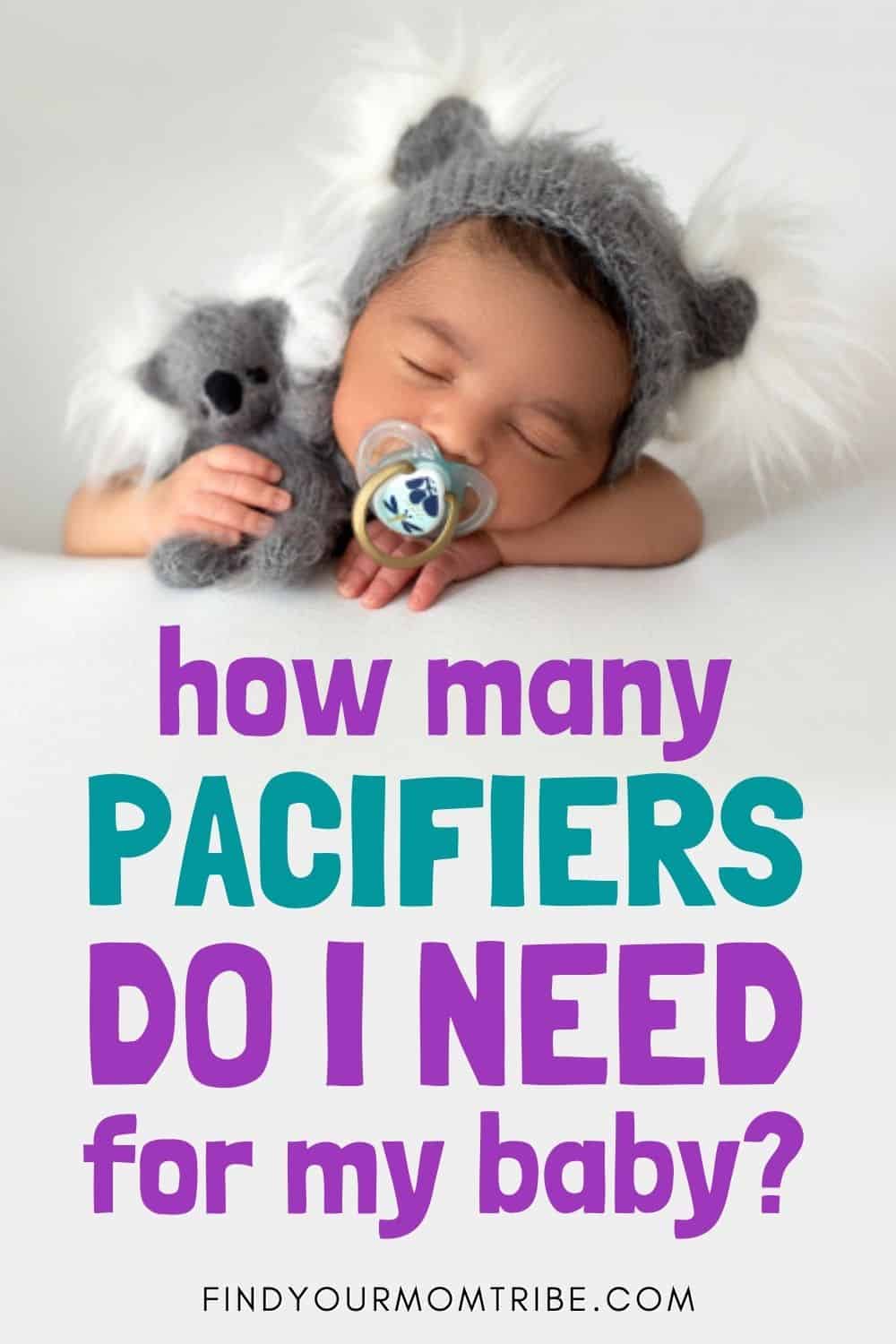
We love honesty! Find Your Mom Tribe is an Amazon Associate and we earn from qualifying purchases through affiliate links at no extra cost to you. Please see our full Amazon Affiliate disclosure for more information.

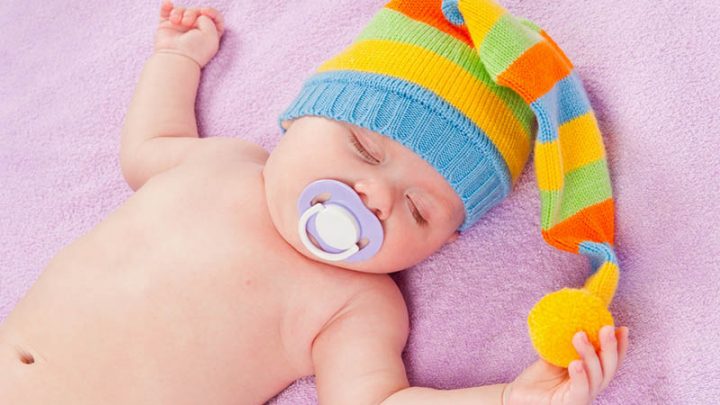




Top 46 How Many Pacifiers Do I Need For A Newborn Quick Answer
Tuesday 29th of November 2022
[…] Read More […]